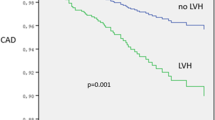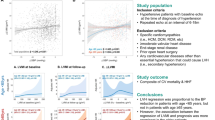Abstract
A relation between left ventricular (LV) hypertrophy and depressed midwall systolic function has been described in hypertensive subjects. However, a strong confounding factor in this relation is concentric geometry, which is both a powerful determinant of depressed midwall systolic function and a correlate of LV mass in hypertension. To evaluate the independent contribution of LV mass to depressed systolic function, 1827 patients with never-treated essential hypertension (age 48 ± 12 years, men 58%) underwent M-mode echocardiography under two-dimensional guidance. Relative wall thickness was the strongest determinant of low midwall fractional shortening (r = −0.63, P < 0.0001). The significant inverse relation observed between LV mass and midwall fractional shortening (r = −0.43, P < 0.0001) persisted after taking into account the effect of relative wall thickness (partial r = −0.27, P < 0.0001). Within each sex-specific quintile of relative wall thickness, prevalence of subnormal afterload-corrected midwall systolic function was greater in subjects with, than in subjects without, LV hypertrophy (P < 0.05 for the first, third, fourth and fifth quintile). In a multiple linear regression analysis, both LV mass (P < 0.0001) and relative wall thickness (P < 0.0001) were independent predictors of a reduced midwall fractional shortening. In conclusion, the inverse association between LV mass and midwall systolic function is partly independent from the effect of relative wall thickness. LV hypertrophy is a determinant of subclinical LV dysfunction independently of the concomitant changes in chamber geometry.
This is a preview of subscription content, access via your institution
Access options
Subscribe to this journal
Receive 12 digital issues and online access to articles
$119.00 per year
only $9.92 per issue
Buy this article
- Purchase on Springer Link
- Instant access to full article PDF
Prices may be subject to local taxes which are calculated during checkout



Similar content being viewed by others
References
Shimizu G et al. Left ventricular midwall mechanics in systemic arterial hypertension: myocardial function is depressed in pressure-overload hypertrophy Circulation 1991 83: 1676–1684
de Simone G et al. Assessment of left ventricular function by the midwall fractional shortening/end-systolic stress relation in human hypertension J Am CollCardiol 1994 23: 1444–1451
Schillaci G et al. Subclinical left ventricular dysfunction in systemic hypertension and the role of 24-hour blood pressure Am J Cardiol 2000 86: 509–513
de Simone G et al. Midwall left ventricular mechanics: an independent predictor of cardiovascular risk in arterial hypertension Circulation 1996 93: 259–265
Muiesan ML et al. Persistence of left ventricular hypertrophy is a stronger predictor of cardiovascular events than baseline left ventricular mass or systolic performance: a 10-year follow-up J Hypertens 1996 14 (Suppl 5): S43–S49
Verdecchia P et al. Prognostic value of midwall shortening fraction and its relation with left ventricular mass in systemic hypertension Am J Cardiol 2001 87: 479–482
Aurigemma GP, Silver KH, Priest MA, Gaasch WH . Geometric changes allow normal ejection fraction despite depressed myocardial shortening in hypertensive left ventricular hypertrophy J Am Coll Cardiol 1995 26: 195–202
de Simone G, Devereux RB, Celentano A, Roman MJ . Left ventricular chamber and wall mechanics in the presence of concentric geometry J Hypertens 1999 17: 1001–1006
Palmon LC et al. Intramural myocardial shortening in hypertensive left ventricular hypertrophy with normal pump function Circulation 1994 89: 122–131
Mayet J et al. Improvement in midwall myocardial shortening with regression of left ventricular hypertrophy Hypertension 2000 36: 755–759
Takahashi M, Sasayama S, Kawai C, Kotoura H . Contractile performance of the hypertrophied ventricle inpatients with systemic hypertension Circulation 1980 62: 116–126
Dong SJ et al. Left ventricular wall thickness and regional systolic function inpatients with hypertrophic cardiomyopathy. A three-dimensional tagged magnetic resonance imaging study Circulation 1994 90: 1200–1209
Sadler DB et al. Systolic function in hypertensive men with concentric remodeling Hypertension 1997 30: 777–781
de Simone G et al. Relation of left ventricular diastolic properties to systolic function in arterial hypertension Circulation 2000 101: 152–157
Verdecchia P et al. Ambulatory blood pressure: an independent predictor of prognosis in essential hypertension [published erratum appears in Hypertension 1995; 25: 462] Hypertension 1994 24: 793–801
Sahn DJ, DeMaria A, Kisslo J, Weyman A the Committee on M-Mode Standardization of the American Society of Echocardiography. Recommendations regarding quantitation in M-Mode echocardiography: results of a survey of echocardiographic measurements Circulation 1978 58: 1072–1083
Devereux RB et al. Echocardiographic assessment of left ventricular hypertrophy: comparison to necropsy findings Am J Cardiol 1986 57: 450–458
de Simone G et al. Left ventricular mass and body size in normotensive children and adults: assessment of allometric relations and the impact of overweight J Am Coll Cardiol 1992 20: 1251–1260
Gaasch WH et al. Stress-shortening relations and myocardial blood flow in compensated and failing canine hearts with pressure-overload hypertrophy Circulation 1989 79: 872–883
Porcellati C et al. Low mid-wall fractional shortening identifies a subgroup of hypertensivepatients with increased left ventricular mass and ambulatory blood pressure J Hypertens 1993 11 (Suppl 5): S102–S103
Palmieri V et al. Effect of type 2 diabetes mellitus on left ventricular geometry and systolic function in hypertensive subjects: Hypertension Genetics Epidemiology Network (HyperGEN) Study Circulation 2001 103: 102–107
Gaasch WH et al. Left ventricular compliance in man: with special reference to normalized ventricular function curves Circulation 1972 45: 746–762
Buttrick P et al. The influence of dietary salt and plasma renin activity on myosin heavy chain gene expression in rat hearts Am J Hypertens 1993 6: 579–585
Mercadier JJ et al. Alpha-myosin heavy chain isoform and atrial size inpatients with various types of mitral valve dysfunction: a quantitative study J Am CollCardiol 1987 9: 1024–1030
Capasso JM, Palackal T, Olivetti G, Anversa P . Left ventricular failure induced by long-term hypertension in rats Circ Res 1990 66: 1400–1412
Anversa P et al. Myocyte cell death and ventricular remodeling Curr Opin Nephrol Hypertens 1997 6: 169–176
Weber KT . Extracellular matrix remodeling in heart failure: a role for de novo angiotensin II generation Circulation 1997 96: 4065–4082
Olivetti G et al. Myocyte nuclear and possible cellular hyperplasia contribute to ventricular remodeling in the hypertrophic senescent heart in humans J Am Coll Cardiol 1994 24: 140–149
Pons-Lladó G et al. Myocardial cell damage in human hypertension J Am Coll Cardiol 2000 36: 2098–2103
Ganau A et al. Relation of left ventricular hemodynamic load and contractile performance to left ventricular mass in hypertension Circulation 1990 81: 25–36
Levy D et al. The progression from hypertension to congestive heart failure JAMA 1996 275: 1556–1562
Gottdiener JS et al. Predictors of congestive heart failure in the elderly: the Cardiovascular Health Study J Am Coll Cardiol 2000 35: 1628–1637
Gardin JM et al. M-mode echocardiographic predictors of six-to-seven years incidence of coronary heart disease, stroke, congestive heart failure, and mortality in an elderly cohort: the Cardiovascular Health Study [abstract] Circulation 1999 100: I-396
Sakata Y et al. Renin angiotensin system-dependent hypertrophy as a contributor to heart failure in hypertensive rats: different characteristics from renin angiotensin system-independent hypertrophy J Am Coll Cardiol 2001 37: 293–299
Hansson L et al. Randomised trial of old and new antihypertensive drugs in elderlypatients: cardiovascular mortality and morbidity the Swedish Trial in Old Patients with Hypertension-2 study Lancet 1999 354: 1751–1756
Muiesan ML et al. Changes in midwall systolic performance and cardiac hypertrophy reduction in hypertensivepatients J Hypertens 2000 18: 1651–1656
Mayet J et al. Improvement in midwall myocardial shortening with regression of left ventricular hypertrophy Hypertension 2000 36: 755–759
Schussheim AE, Diamond JA, Phillips RA . Left ventricular midwall function improves with antihypertensive therapy and regression of left ventricular hypertrophy inpatients with asymptomatic hypertension Am J Cardiol 2001 87: 61–65
Author information
Authors and Affiliations
Corresponding author
Rights and permissions
About this article
Cite this article
Schillaci, G., Vaudo, G., Pasqualini, L. et al. Left ventricular mass and systolic dysfunction in essential hypertension. J Hum Hypertens 16, 117–122 (2002). https://doi.org/10.1038/sj.jhh.1001302
Received:
Revised:
Accepted:
Published:
Issue Date:
DOI: https://doi.org/10.1038/sj.jhh.1001302
Keywords
This article is cited by
-
Relationship between overweight and obesity and cardiac dimensions and function in a paediatric population
European Journal of Pediatrics (2022)
-
Cardio-ankle vascular index and subclinical heart disease
Hypertension Research (2015)
-
Determinants of discrepancy between left ventricular chamber systolic performance and effective myocardial contractility in subjects with hypertension
Journal of Human Hypertension (2006)
-
Insulin resistance and vascular remodelling, in relation to left ventricular mass, geometry and function: an answer to LIFE?
Journal of Human Hypertension (2003)



